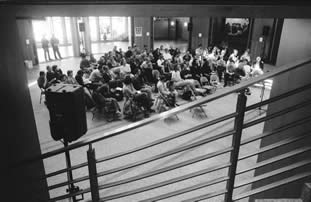Sound Installations
Altering the experience of space
My electroacoustic compositions are normally presented in two ways: on CD or in a concert. In both these instances the audience’s response to my work is not easily accessible. There is no way of knowing the response to listeners of the CD and there are a number of things that go on in a concert hall that mediate the audience’s reaction to a piece. Their visual presence is blackened out, their soundmaking is extremely restricted and prescribed, and opportunities for comment are largely kept within private conversations.
Audience responses to a site-specific sound installation, however, are much more evident, particularly when the installation changes the sonic environment of a space that is frequented by the same people on a regular basis. In the case with both my sound installations Soundscape Carillon at Kitchener City Hall and Streams of Whispers at the Latvian House in Toronto, the physical reactions to the newly created soundscapes were immediately evident due to the public nature of both spaces. It was interesting to watch a person’s reactions as he or she walked through the space. The direction of his or her walking would change suddenly, or he or she would stop mid-stride to fully absorb the experience.

There is greater opportunity for audience dialogue and discussion when the artist or a representative of a piece is present during the sound installation. People have a funny way of seeking out that one person in the space who appears responsible for any unexpected changes in their sonic environment. A dialogue can occur between the artist and audience member that I think is more honest and direct then the conversations I have had after my piece has been played at a concert. Perhaps this is because the people who participate in this dialogue approach it with a vested interest in the space which the installation has unexpectedly altered.
The role of the audience has changed with the different sites I have chosen for my installations. In my previous installation pieces, the sounds that the audience would normally make in the space–footsteps and conversations–blended in with the overall soundscape of the installation, but did not directly control its sound output. The installation happened in spite of them, no matter how much care was invested in the integration of the installation with the space.
With my piece for Sign Waves Phase II, Reservoir, the audience is not in a public space that is familiar to them and the installation will require them to actively participate. In fact, the visitors to the site are invited to make their own sounds that will be an integral part of the soundscape of the piece. In Reservoir, there is a microphone positioned in a room where audience members can input sound into an acoustic feedback circuit. This circuit channels their vocalizations from the Chemistry lab to and through the resonating wells of the unseen water reservoir (located underground next to the Chemistry lab) and then back to the Chemistry lab which has a very distinct room resonance of its own. Audience members off-site can also input sound into this circuit in real time by calling a designated phone number. The installation will only become active if sound is provided, otherwise it will be silent.

All of my installations use sound to alter the experience of space. The installations create a mood or atmosphere for a particular space and also focus attention on important features that might not be readily known, such as important cultural events associated with its past. Michael Davey’s and Delwyn Higgens’ painting of the hundreds of access covers in the field outside the Chemistry Building provide the main point of visual interest for Reservoir as audiences look out through the windows of the Chemistry building. The sound component of Reservoir responds to that source of visual interest by making direct reference to the acoustic resonance of the large water reservoirs underneath those access covers.
Although Reservoir has been made for the Chemistry building, the feedback system used in it can be easily used on another site. The technical basis for the circuit is the connection of multiple spaces in a loop so that the resonance of one space continuously feeds into that of another. What makes Reservoir unique is its location and the nature of the acoustic spaces that are connected by the feedback circuit. There is the large resonance of the water reservoirs, the very colourful resonant frequencies of the room in the Chemistry building, and the sounds that people make upon encountering and interacting with the sounds made by the feedback circuit. In this sense, these factors make Reservoir not only specific to its location but also specific to the people who encounter it at any time and place.
Social top